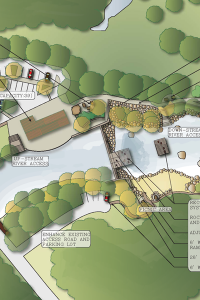Colorado river park crafted as world-class whitewater recreation and competition venue.
Colorado rafters, kayakers and stand-up paddleboarders will have a great new playpark to surf this spring when the new Eagle River Park opens in the town of Eagle. S2O Design, the world’s premier river engineering and whitewater design company, announced today that they are finalizing construction on the in-stream features that will provide an exciting and safe experience for river enthusiasts of all levels.
“We are excited to deliver a great whitewater park for the town of Eagle,” says Scott Shipley, founder and president of S2O Design, which oversaw the project’s design, planning, permitting, and construction. “This setting matches the river’s natural morphology and utilizes the existing river channel really well. It will surely be a new focal point for the town.” Shipley is also a three-time Olympian and five-time World Cup slalom kayak champion.
The two-year revitalization project involved an in-depth feasibility study, comprehensive public input process, and a progressive design approach that included detailed hydraulic modeling. The project’s first phase, including the initial study and building two downstream features, was completed last spring. S2O Design has now completed the second phase of the project, including two more advanced upstream features as well as extensive bankside improvements. Additional features include gathering areas, pathway, and public park.
S2O’s design focused on creating a world-class whitewater venue for recreation, competitions and festivals while providing long-term riparian and habitat improvements. The whitewater park features waves, eddies, chutes, and drops that will be fun to tube and float during low flows, and large waves perfect for surfing, standup-up paddling and kayaking as flows increase.
Marking the first time ever for an in-stream project, S2O incorporated its patented, adjustable RapidBlocs™ technology into the project, which allows the features to be fine-tuned for different conditions. “We’ll be able to tweak them however we need to,” says Shipley. The design also includes a bypass channel around the two upper features serving as a recreational safe route and a fish migration pathway, and mid-stream fish channels in the lower section for upstream migration.
The Eagle River Park was funded by the Town of Eagle (in 2016 voters approved a 0.5% sales tax to fund park and trail improvements), various matching grants, and donors like local business Bonfire Brewing. Vetted through an extensive public process, and a cooperative effort with Colorado Parks and Wildlife, it is a central part of the Eagle River Corridor Plan established in 2015. The park is also easily visible from I-70, which will pull passersby into the community.
“The Eagle River Park has been on the wishlist of boaters and residents for decades,” says town Trustee Matt Solomon. “This amenity will truly connect the soul of the river to the heart of our valley.” Adds town of Eagle Marketing Manger Jeremy Gross: “The project has been a successful collaboration between the town, S20, the U.S. Army Corp of Engineers, our construction team and countless others. The knowledge and experience from all of these groups has made it a smooth project considering the extent of the undertaking.”
And no one is more excited about the project’s completion than local paddlers. “This park is going to make a huge, positive impact on Eagle as well as all the other nearby river corridor communities,” says former pro kayaker and sup paddler Ken Hoeve. “The features are perfect for surfing, standup paddling and kayaking. The park is going to put Eagle on the map as a great paddling destination.”
S2O Design is also completing in-channel whitewater parks on the Poudre River in Fort Collins, Colo., on the Arkansas River in Canon City, Colo., and on the Boise River in Boise, Idaho, bringing additional venues for rafting and surfing to the Rocky Mountain region.














